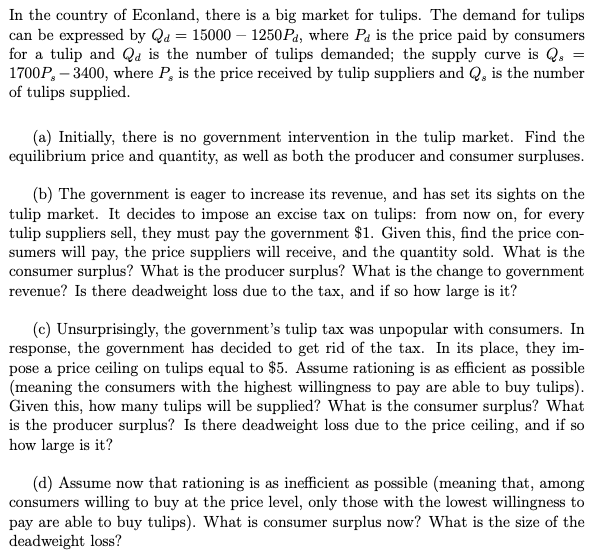Chapter4: Demand, Supply, And Market Equilibrium
Section: Chapter Questions
Problem 4P
Related questions
Question
Please Answer Part "b" only

Transcribed Image Text:In the country of Econland, there is a big market for tulips. The demand for tulips
can be expressed by Qd = 15000 – 1250Pa, where Pa is the price paid by consumers
for a tulip and Qa is the number of tulips demanded; the supply curve is Q, =
1700P, – 3400, where P, is the price received by tulip suppliers and Q, is the number
of tulips supplied.
(a) Initially, there is no government intervention in the tulip market. Find the
equilibrium price and quantity, as well as both the producer and consumer surpluses.
(b) The government is eager to increase its revenue, and has set its sights on the
tulip market. It decides to impose an excise tax on tulips: from now on, for every
tulip suppliers sell, they must pay the government $1. Given this, find the price con-
sumers will pay, the price suppliers will receive, and the quantity sold. What is the
consumer surplus? What is the producer surplus? What is the change to government
revenue? Is there deadweight loss due to the tax, and if so how large is it?
(c) Unsurprisingly, the government's tulip tax was unpopular with consumers. In
response, the government has decided to get rid of the tax. In its place, they im-
pose a price ceiling on tulips equal to $5. Assume rationing is as efficient as possible
(meaning the consumers with the highest willingness to pay are able to buy tulips).
Given this, how many tulips will be supplied? What is the consumer surplus? What
is the producer surplus? Is there deadweight loss due to the price ceiling, and if so
how large is it?
(d) Assume now that rationing is as inefficient as possible (meaning that, among
consumers willing to buy at the price level, only those with the lowest willingness to
pay are able to buy tulips). What is consumer surplus now? What is the size of the
deadweight loss?
Expert Solution
This question has been solved!
Explore an expertly crafted, step-by-step solution for a thorough understanding of key concepts.
This is a popular solution!
Trending now
This is a popular solution!
Step by step
Solved in 5 steps with 1 images

Knowledge Booster
Learn more about
Need a deep-dive on the concept behind this application? Look no further. Learn more about this topic, economics and related others by exploring similar questions and additional content below.Recommended textbooks for you

Exploring Economics
Economics
ISBN:
9781544336329
Author:
Robert L. Sexton
Publisher:
SAGE Publications, Inc


Exploring Economics
Economics
ISBN:
9781544336329
Author:
Robert L. Sexton
Publisher:
SAGE Publications, Inc
